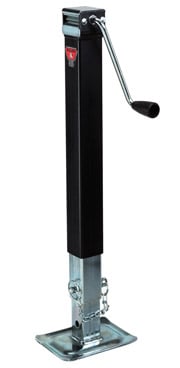Four Methods of Work Platform Actuation: Which is Best for You?
Going up! One of the characteristics that make modern work platforms so effective is their ability to be raised and lowered to a variety of access points on a piece of equipment. It seems like a simple thing, but work platform manufacturers actually put a lot of thought into the best type of actuation to use for a particular environment. Below are the four main methods of work stand actuation, as well as the situation in which they are best suited.
Manual Actuation
Manual screw jacks provide the simplest method of elevating a work platform. Because they require no electrical service, they are completely portable and can be used in virtually any setting. In addition, they allow you to make small adjustments, and once they’re set they will never drift down. However, manual jacks take a bit of physical effort to elevate, and at a certain range of adjustability the time it takes becomes impractical.
Price: Low component cost, low operational/maintenance cost
Best for: Work platforms requiring 1’ to 3’ of height adjustability
Electrical Actuation
Electrical linear actuators take no more effort to raise and lower than the push of a button, and they are known for their high level of precision. You can choose between two versions: mains (120v or 240v) or 12v/24v DC. Mains actuation provides fast, smooth, and easy elevation, and it is completely safe when wired to the electrical codes of the usage country. However, it must be plugged in whenever the platform height needs to be adjusted.
 Twelve volt or 24 volt DC actuators use batteries for power, so they are completely portable. They may also be considered safer than mains due to the low voltage. The batteries do need to be recharged regularly, but they typically last through several cycles.
Twelve volt or 24 volt DC actuators use batteries for power, so they are completely portable. They may also be considered safer than mains due to the low voltage. The batteries do need to be recharged regularly, but they typically last through several cycles.
One concern some facilities have with electrical actuators - really, any actuation method that is not manual - is that it becomes too easy to raise or lower the platform, increasing the risk of damage to equipment when clearance isn't properly verified. Fortunately, the actuators move relatively slow and stop instantly. With proper user training, this risk can be significantly reduced.
Price: High component cost, low operational/maintenance cost
Best for: Maintenance or manufacturing/production facilities, extended range systems
Hydraulic Actuation
Once the standard method of elevating work platforms with a large range of adjustability, hydraulic jacks and cylinders are becoming somewhat less popular. That’s not to say they have no place in the industry. Hydraulic actuators come in two forms: electric over hydraulic and manual. The electric over hydraulic actuator systems require power to elevate, while the manual versions are fully portable. Both types allow easier actuation than a manual screw jack; in addition, actuation can be done remotely, allowing you to place cylinders in locations that are difficult to access.
 However, hydraulic jacks, pumps, and cylinders have greater servicing requirements than either manual or electric screw jacks. Worse, the potential for creep or complete failure requires redundancies to be put in place to safely secure the platform at height. A sinking platform is especially dangerous when placed next to aircraft or other equipment with delicate exteriors.
However, hydraulic jacks, pumps, and cylinders have greater servicing requirements than either manual or electric screw jacks. Worse, the potential for creep or complete failure requires redundancies to be put in place to safely secure the platform at height. A sinking platform is especially dangerous when placed next to aircraft or other equipment with delicate exteriors.
Price: Mid-range component cost, high operational/maintenance cost
Best for use in: Dirty, remote environments, extended lift systems, inaccessible locations
Pneumatic Actuation
 Pneumatic actuators have essentially the same pros and cons as hydraulic jacks. Their greatest benefit is that they can be used in explosion-proof environments or clean settings where hydraulic fluid would pose a problem. One challenge is that they require larger cylinders than hydraulic jacks, somewhat limiting the types of locations suitable for their use. In addition, it may be more difficult to spot leaks in pneumatic actuators, and seeping can be a problem. Finally, pneumatic actuators are best suited for end-to-end motion rather than precision positioning.
Pneumatic actuators have essentially the same pros and cons as hydraulic jacks. Their greatest benefit is that they can be used in explosion-proof environments or clean settings where hydraulic fluid would pose a problem. One challenge is that they require larger cylinders than hydraulic jacks, somewhat limiting the types of locations suitable for their use. In addition, it may be more difficult to spot leaks in pneumatic actuators, and seeping can be a problem. Finally, pneumatic actuators are best suited for end-to-end motion rather than precision positioning.
Price: Low component cost, high operational/maintenance cost
Best for use in: Clean rooms and explosion-proof environments
Are you interested in work platform design? You may want to check out these other posts:


